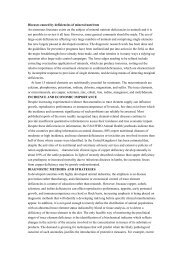Technological and Technical Development of Tobacco Drying
Technological and Technical Development of Tobacco Drying
Technological and Technical Development of Tobacco Drying
You also want an ePaper? Increase the reach of your titles
YUMPU automatically turns print PDFs into web optimized ePapers that Google loves.
Air dem<strong>and</strong>,<br />
[kg/kg wate<br />
Heat dem<strong>and</strong>,<br />
[kJ/kg water<br />
90<br />
80<br />
70<br />
60<br />
50<br />
40<br />
30<br />
20<br />
10<br />
0<br />
6000<br />
5000<br />
4000<br />
3000<br />
2000<br />
1000<br />
new<br />
technology<br />
conventional<br />
technology<br />
8 32 56 72 92 104 124 136<br />
0<br />
Curing time, T [h]<br />
Figure 3. Variation <strong>of</strong> the air dem<strong>and</strong> <strong>of</strong> curing.<br />
new<br />
technology<br />
conventional<br />
technology<br />
8 32 56 72 92 104 124 136<br />
Curing time, T [h]<br />
Figure 4. Variation <strong>of</strong> the heat requirement <strong>of</strong> curing.<br />
The main aim was to monitor the influence <strong>of</strong> different practical features on the important quality<br />
characteristics. Fulfilling this requirement, I arranged to study altogether four curing cycles on two farms,<br />
applying a conventional <strong>and</strong> an advanced technology at the same time.<br />
Four samples were taken from each curing barn <strong>and</strong> transported to the local quality-testing laboratory <strong>of</strong><br />
the tobacco processing company, where the four most important internal components were identified<br />
(carbohydrate, reducing, sugar, total nitrogen, nicotine). In addition they measured the moisture content.<br />
The results <strong>of</strong> the analytical work are summarized in Table 2.















